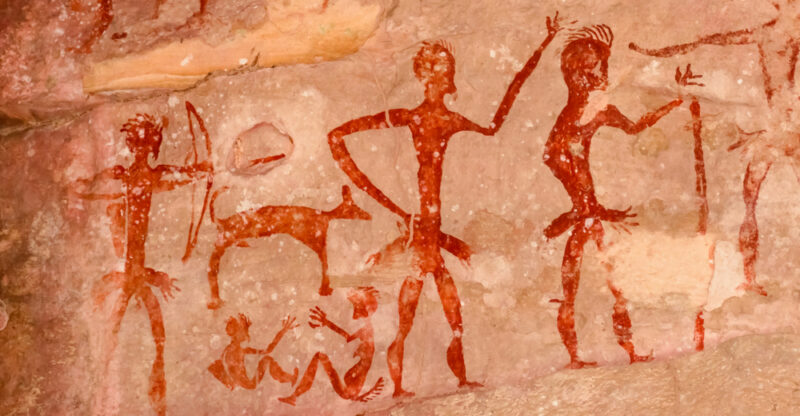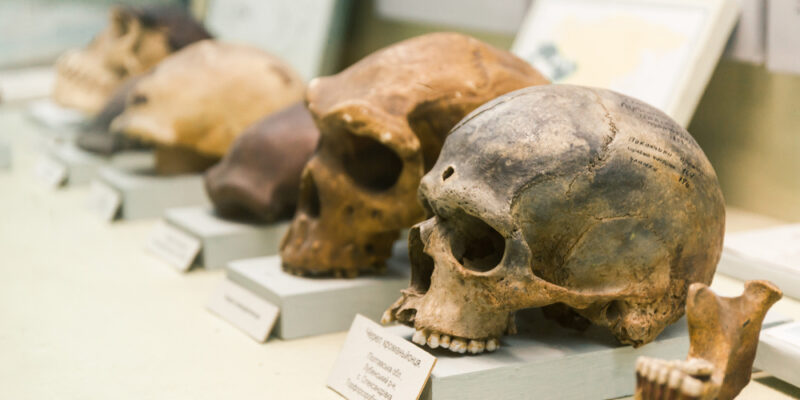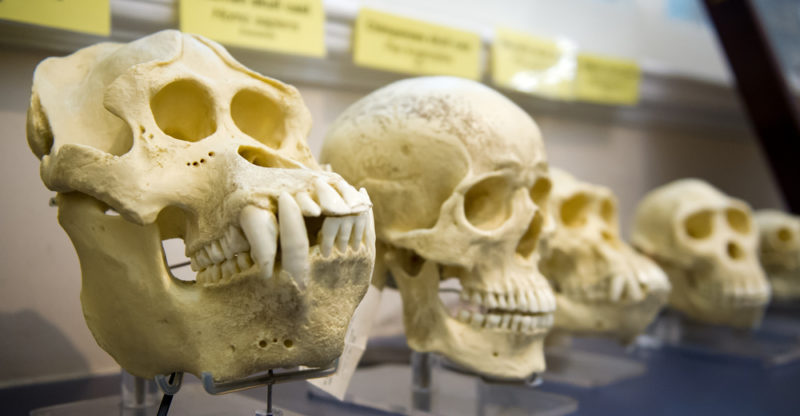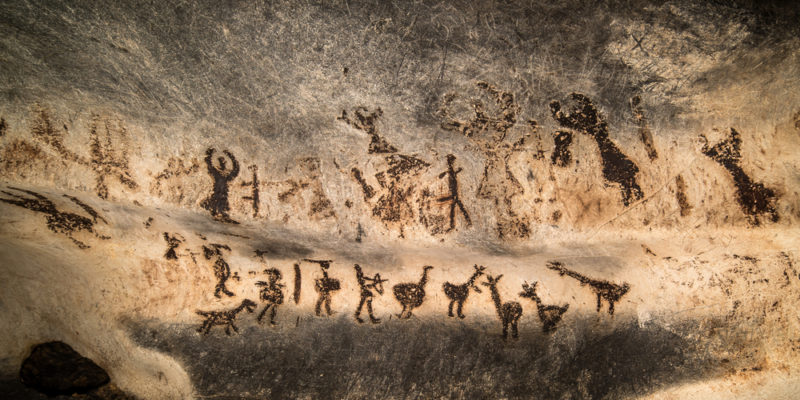We explain human origin, and the main theories of human evolution. In addition, we explore the human species that existed, and their characteristics.

How did humans originate?
Human evolution is the evolutionary process encompassing all the biological and cultural transformations that the human species underwent leading up to modern human traits. This process is also known as hominization and is strongly linked to the "theory of evolution".
Hominids known as Australopithecus, inhabiting Africa 4 million years ago, are believed to have been the first ancestors of the human species. Subsequently, different genera of humans, (called Homo) originated, evolved, and became extinct until the emergence of the genus Homo sapiens sapiens, to which modern humans belong.
In order to understand human evolution, interdisciplinary research is conducted across multiple disciplines, such as anthropology, genetics, paleontology, stratigraphy, geochronology, archaeology, and even linguistics.
- See also: Hominin
Theories of human origin

Throughout history, all cultures have attempted to explain human origin through myths and tales, often in relation to the creation of the world by deities. With the rise of major monotheistic religions, like Judaism, Christianity, and Islam, human origin came to be explained through religious texts that proclaimed their message as the sole truth.
From the social sciences standpoint, myths and religious stories are not sufficient explanation to account for the origin of man, which they therefore approach based on the theory of evolution.
In the 19th century, Charles Darwin wrote his book “On the Origin of Species”, in which he posited his theory of evolution. Darwin held that some individuals within each species present mutations in certain biological traits that may be naturally selected by the environment, thus favoring the survival of these individuals, which will have a greater chance of passing on the mutations to their descendants.
Today, this theory is combined with genetic research and the synthetic theory of evolution, which holds that all species are the result of the accumulation of successive changes over vast spans of time.
Human evolution was not a linear process. Archaeological evidence suggests that some species of the genus Homo, from which modern humans descend, coexisted in time, some of which became extinct while others evolved.
Origin of man
Like other living species, the human species was shaped over millions of years, through a complex process of transformations called evolution. All genera of humans that were part of this evolution are called hominids.
Scientists believe the first human ancestors were the Australopithecus, a genus of hominids that inhabited Africa four million years ago. Australopithecus were primates, a type of mammals characterized by hands with five fingers and opposable thumbs (i.e. one finger opposing the other four, capable of grasping objects), a complex brain, central vision, and females with a monthly fertility cycle.
This group of primates also includes gorillas, chimpanzees, and orangutans, but these genera did not undergo the same evolutionary transformation process.
Four million years ago, the Earth experienced climatic changes, transforming the African rainforest into a savanna. This environmental change favored Australopithecus, as they were bipeds (i.e. they walked on two legs). Being bipedal freed their hands for other tasks, such as collecting fruit from the ground, gathering edible roots and tubers, and grasping sticks and stones. Furthermore, alongside with their central vision, the bipedal gait allowed them to detect the proximity of predators in the savanna environment (covered with mid-height grasses), as well as to travel longer distances over territory.
- See also: Australopithecus
Human evolution timeline
From Australopithecus evolved the genus Homo, ancestral to the different human categories that, in turn, evolved into modern humans. Human evolution was not a linear process, and different human species coexisted over time and across different regions. Over 18 different species have been identified within the genus Homo.
The following timeline broadly represents the evolutionary leaps of the human species:
- Homo habilis. They inhabited Africa 2.5 million years ago. They reached a height of 4 ft 6 in (1.40 m), and their cranial capacity was up to 700 cc. They developed speech, made tools, and built temporary shelters.
- Homo erectus. They migrated across Africa, Europe, Asia, and Oceania around 1.5 million years ago. They reached a height of 5 ft 2 in (1.60 m), and had a cranial capacity of up to 1,000 cc. They hunted small animals, lived in camps and caves, and learned to control fire.
- Homo sapiens. They inhabited Africa, Europe, Asia and Oceania. Starting 500,000 years ago, they began an evolutionary process evolving from Homo erectus. The earliest fossils of Homo sapiens as a clearly distinct species date back to 200,000 years ago. They reached a height of 5 ft 6 in (1.70 m). Their cranial capacity reached 1,500 cc, and scientists believe they had an intellectual potential equivalent to that of modern humans. They made more elaborate tools, made more complex use of language, and buried their dead.
- Homo neanderthalensis. They inhabited Europe and Asia from around 230,000 years ago until 30,000 years ago. They were hunters and lived in larger groups. Scientists initially categorized the earliest fossil remains of homo neanderthalensis as a distinct genus homo. Nowadays, however, they are classified as a subspecies within the genus Homo sapiens. In the later period, they coexisted with Homo sapiens sapiens, direct ancestor of modern humans. The reasons for their extinction remain unknown.
- Homo sapiens sapiens. They inhabited Africa, Asia, Europe, Oceania, and the Americas. It is the species to which modern humans belong. The oldest fossil remains date back to around 2,000 years ago. They mastered group hunting techniques on large animals, practiced religious rites, and represented reality in paintings and sculptures.
- See also: Human evolution
Characteristics of human evolution
The main biological mutations that marked human evolution include:
- Bipedalism
- Opposable thumbs
- Cerebration
The most significant cultural aspects of human evolution include:
- Emergence of language
- Symbolic representation
Bipedalism
The upright posture on the hind limbs would have arisen for more efficient mobility across the African savannas. This would have allowed early hominids to run at faster speeds and to keep a vantage point above tall grasses, which could potentially hide predators.
Individuals walking on two legs had a better chance of survival compared to those relying on all four. Over time, this trait became predominant, leading to anatomical changes positioning the skull firmly on top of the spine.
Opposable thumbs

As hominids began to walk upright, their upper limbs were freed, meaning they no longer needed them to move from one place to another. This allowed them to use their hands for other tasks, such as eating while walking, holding their offspring while escaping from predators, carrying food, or using tools.
Stones, bones, and pieces of wood were among the early tools that our ancestors had. These rudimentary tools mark the beginning of a technological journey leading up to the sophisticated tools we have today.
Cerebration

As we progress in the lineage of pre-human hominids, there is a noticeable increase in cranial capacity: from the 350 cc of the earliest Australopithecus to the 1,200 to 1,400 cc of Homo sapiens.
This growth in brain volume suggests a heightened ability for more complex cognitive processes, broader and deeper reasoning, and faster thought processes. Furthermore, it allowed for enhanced learning and abstraction, a defining feature that distinguishes us from other animals.
Emergence of language
While communication is a common trait to all life forms, language is distinctly human.
Some animals can understand and associate certain instructions regarding desired or undesired behaviors. Others, like chimpanzees, are able to comprehend certain communication basics through sign language.
However, in none of these cases is it an articulate language. A system based on sounds and signs transformed into complex ideas is unique to our species.
Art and culture

The most sophisticated forms of culture and artistic expression among all the human species that ever existed were achieved by Homo sapiens. Nevertheless, some ancestors also left traces of their existence. In addition, Neanderthals are thought to have left cave art and other forms of prehistoric art.
In our civilization, art and culture are a reflection of our thinking skills, of our expressive and creative spirit. Moreover, they are a highly valued aspect of our existence, something unique among all forms of animal life.
Explore next:
References
- López Serrano, A. (1996). Proceso de hominización y cultura material. La aportación de la antropología histórica.
- Harris, M. (1981). Introducción a la antropología general. Alianza.
- Leakey, R., & Lewin, R. (1994). Nuestros orígenes. RBA editores.
- “Evolución humana”. Wikipedia.
- “Evolución del hombre”. Profe en Historia.
- “The Evolution of Humans” (video). FuseSchool – Global Education.
- “Los conceptos básicos de la evolución humana”. National Geographic.
- “Introduction to Human Evolution”. Smithsonian National Museum of Natural History.
- “Human evolution”. The Encyclopaedia Britannica.
Was this information useful to you?
Yes NoThank you for visiting us :)